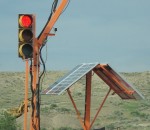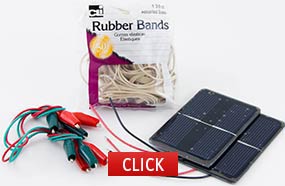We may never drive cars covered in photovoltaic cells like the one in this picture, but building a miniature solar car is a fun way to see how solar energy can be used for power.
Make Your Own Solar Car
In this project you will need creativity and experimentation to design and build a car powered by two solar cells and a small electric motor. The National Renewable Energy Laboratory has a PDF curriculum that will also give you ideas and help you learn about the scientific and engineering principles behind building a solar car. (Adult supervision is recommended for this project.)
What You Need:
- 2 solar cells
- 2-4 alligator clip leads
- Rubber bands
- Small electric motor (Look at hobby or electronics stores, and make sure you get one with a motor pulley)
- For the car body: cardboard milk carton, water bottle, cardboard, foam board, or similar materials
- For the wheels: plastic bottle caps, film canister caps, toy wheels such as K’nex, etc.
- For the axles: Stiff wire or wooden shish-kabob skewers
- Straws or eye screws to mount the axles
What You Do:
1. Choose a material for the car body, which is called the chassis. Think carefully about this: you want something strong, but also something lightweight so it needs less power for the motor to move it. (But be careful — if it’s too light, it can easily get blown about by the wind.) A big part of engineering is finding the right balance between weight and strength.
2. Use a nail to poke a small hole in the center of your wheels. Make sure the stiff wire or wooden skewers you use for axles fit in the holes tightly. Take an extra cap and cut off the sides, leaving just the top part, which usually has a small inner rim to help keep the bottle from leaking. Glue this cap to one of your wheels. You have just created a pulley for your driving wheel; the inner rim of the extra bottle cap will support your car’s drive belt. (You can try using a film canister cap for this step instead of cutting a bottle cap. If you are using toy wheels like K’nex, you can just use a smaller wheel mounted on the inside of your main wheel to act as the pulley.)
3. Now, mount your axles onto the chassis. Depending on what your chassis is made of, you can thread the axle through eye screws mounted on the bottom. Another easy method is to tape straws on the underside of the chassis and thread the axles through them. (Use our balloon rocket car project as reference for how to do this.)
4. Attach the small motor pulley to the motor shaft. Determine where to mount the motor by connecting the driving pulley with the motor pulley using an elastic band as a drive belt. Position the motor so the band is slightly stretched (but don’t stretch it too much!). Mount the motor with glue or tape it in between a small frame of wood or cardboard blocks.
5. Use clear plastic tape to attach the two solar cells together side-by-side; then connect them in a series circuit using the alligator clip leads. Connect the positive terminal of one cell to the negative terminal of the other. Connect the remaining terminals to the motor. If the motor spins the wrong way, switch the leads where they connect to the motor. Once it’s connected properly, you’ll probably want to use to tape to help keep the wires under control.
6. Mount the solar cells on the chassis at an angle where they will receive the most sun. Take your car outside to a sunny sidewalk, connect the drive belt, and watch it go!
Designing and building a car from scratch involves a lot of perseverance and trial and error, so don’t be discouraged if yours doesn’t work perfectly right away. Experiment to see if you can improve the design of your solar car. How fast does it go? Does it drive straight? How would it perform with only one solar cell? What if you used smoother wheels for less friction? Keep testing new ideas to make your car work better.
Once you’ve perfected your car, think about other ways you could experiment with solar power. Could you build a solar boat or water pump? Could you perform electrolysis to divide water into hydrogen and oxygen using a solar panel? How can we harness the amazing power of the sun? Maybe you’ll be the next scientist to help find out!
For more solar science fun, check out these projects:
Solar Power Science Lesson
The Sun: The Ultimate Power Source
Every morning the sun rises, bringing light and heat to the earth, and every evening it sets. It seems so commonplace that we rarely spare a thought for that bright object in the sky. Yet without it, we wouldn’t exist!
Deep in the core of our local star, hydrogen atoms react by nuclear fusion, producing a massive amount of energy that streams in all directions at the speed of light (that’s the mind-boggling speed of more than 186,000 miles per second). In just eight minutes, that energy travels 93 million miles to earth.
We use many different forms of energy here on earth, but here’s the thing: almost all of them originate with the sun, not just light and heat (thermal) energy! The law of conservation of energy says that energy can’t be created or destroyed, but can change its form. And that’s what happens with energy from the sun —it changes into lots of different forms:
- Plants convert light energy from the sun into chemical energy (food) by the process of photosynthesis. Animals eat plants and use that same chemical energy for all their activities.
- Heat energy from the sun causes changing weather patterns that produce wind. Wind turbines then convert wind power into electrical energy.
- Hydroelectricity is electrical energy produced from moving water, and water flows because heat energy from the sun causes evaporation that keeps water moving through the water cycle.
- Right now, much human activity uses energy from fossil fuels such as coal, oil, and natural gas. These energy sources are created over very long periods of time from decayed and fossilized living matter (animals and plants), and the energy in that living matter originally came from the sun through photosynthesis.
The sun sends more energy to the earth in one hour than the whole planet needs in a year. Imagine if we could capture that energy directly and convert it to a form that could power our cities, homes, and cars! Many scientists around the world are researching how we can improve our use of the sun’s energy. One way is to use solar thermal panels to collect thermal energy to heat air and water. Another way is to use photovoltaic (PV) cells, also called solar cells, to convert sunlight directly into electricity. (‘Photovoltaic’ essentially means ‘light electricity’.)
PV cells use a material such as silicon to absorb energy from sunlight. The sunlight energy causes some electrons to break free from the silicon atoms in the cell. Because of how the solar cell is made, these free electrons move to one side of the cell, creating a negative charge and leaving a positive charge on the other side. When the cell is hooked up in a circuit with wires, the electrons will flow through the wires from the negative side to the positive side, just like a battery. This electron flow is electricity, and it will power a load (light bulb, motor, etc.) you connect to its path.
 PV cells today are still only able to capture a small fraction of the sun’s energy, so acres of them are necessary to collect enough light to create electricity on a large scale. A lot more scientific work needs to be done to make them more efficient and take up less space. Despite the challenges, solar panels are used to power many things such as emergency signs, school crossing lights, and more. Many people are also able to power their homes by mounting solar panels on the roof, and this will only get easier as the technology continues to advance.
PV cells today are still only able to capture a small fraction of the sun’s energy, so acres of them are necessary to collect enough light to create electricity on a large scale. A lot more scientific work needs to be done to make them more efficient and take up less space. Despite the challenges, solar panels are used to power many things such as emergency signs, school crossing lights, and more. Many people are also able to power their homes by mounting solar panels on the roof, and this will only get easier as the technology continues to advance.






